How to raise asparagus and culture methods
Asparagus, also known as Pinus elliottii, Pinus elliottii, Phyllostachys pubescens, is a perennial evergreen vine foliage plant, a famous ornamental plant. Asparagus is a plant of the genus asparagus of Liliaceae. It is mainly seen in potted plants and is also an important leaf-cutting material. Asparagus can not only improve cultural accomplishment, but also regulate people with liver disease, depression and depression. Asparagus can not only absorb harmful gases such as sulfur dioxide, nitrogen dioxide and chlorine at night, but also secrete gases that kill bacteria and reduce the occurrence of infectious diseases such as colds, typhoid and laryngitis, which is of great benefit to human health.
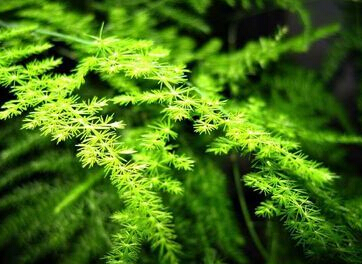
Steps
1. Asparagus is suitable for growing in warm and humid soil rich in rotten branches and good drainage. Asparagus is afraid of smoke and dust, and if it encounters poisonous gases, its branches and leaves are prone to yellowing. For this reason, attention should be paid to putting it in a clean environment during maintenance. Asparagus should be fertile soil, if there is no soil change for a long time, nutrients are in short supply, there will be branches and leaves yellowing phenomenon. At this time, it is necessary to pour mature thin liquid fertilizer or compound chemical fertilizer once a week, and water and loosen the soil in time, so that it can change from yellow to green soon. If the fertilizer is too thick or unmature fertilizer is applied, it is easy to cause "watering the root", resulting in the drying and shedding of the leaves. At this time, it is necessary to pour the pot to remove the fertilizer, irrigate the soil block with clean water, and then change it into the new culture soil.
two。 If the potted asparagus is watered too much, the soil is too sticky and the drainage is poor, the leaves of asparagus will become scorched yellow and fall off, which will affect the growth of asparagus. Generally need to wait for the basin soil to see dry before watering, spring and autumn season should reduce watering, adhere to do not water, winter control watering. Excessive watering can easily cause root rot and leaf yellow shedding when the basin soil is too wet. When watering, we should pay attention to the water temperature should be as close as possible to the surrounding temperature, so as to reduce the stimulation of water temperature discomfort to the root system. Spray the leaves with water when the weather is hot and dry.
3. Asparagus is not a good fertilizer plant, but it can not be short of fertilizer. Potted asparagus is limited by potted soil, so it is necessary to replenish nutrients in time to meet its growth requirements. Asparagus fertilization should be thin and diligent, do not apply thick fertilizer, otherwise it is easy to cause branches and leaves to turn yellow. The growing season in spring and summer is dominated by nitrogen fertilizer. The mature thin liquid fertilizer can be applied once a month. When the plant is stereotyped, fertilization should be properly controlled to avoid excessive growth and affect the beauty of the plant type.
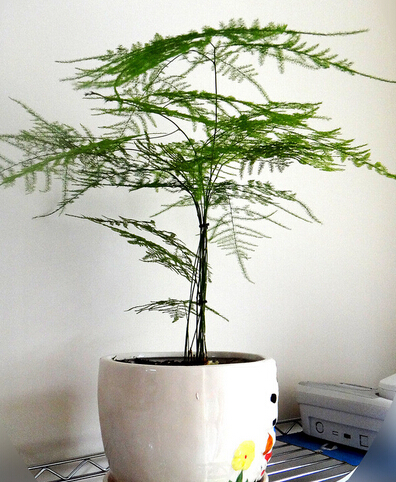
Points for attention
A) the light is too strong. Asparagus likes semi-shade and avoids strong light. If it is placed in direct sunlight in summer, it will cause branches and leaves to wither and yellow. Once this phenomenon occurs, the flowerpot should be moved to a cool place, and water is often sprayed on the branches and leaves to increase the relative humidity, most of which are not seriously damaged can be restored.
B) improper watering. Although asparagus likes to be wet, it is afraid of stagnant water in the basin. More water is easy to rot the roots, while less water is easy to dry up the leaf tip. If root rot occurs, watering should be controlled and the soil should be loosened often. If the leaf tip is dry and withered, it is appropriate to irrigate a small amount of water first, then increase gradually, and spray water on the branches and leaves at the same time.
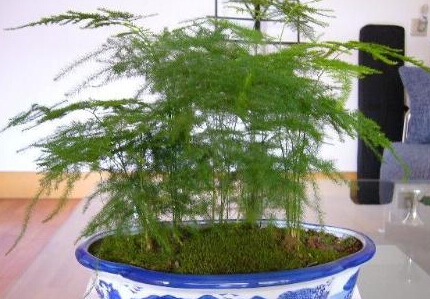
Shaping method
1. Pot control method: the ratio of flowerpot to plant size should be 1:3, which can limit the growth of root system and keep the plant size unchanged.
2. Remove the growing point: when the new bud reaches 2~3cm, it can promote the regeneration of branches and leaves on the stem, control its non-growing vines, flatten out the branches and leaves, and make the plant shape plump.
3. Making use of the phototaxis of asparagus: turning the direction of the flowerpot at the right time can modify the growth shape of branches and leaves and keep the plant type unchanged.
4. Object shielding method: that is, using a piece of hard paper to press the branches and leaves or cover the sun, so that when the branches and leaves are growing, the stems will turn or bend when they encounter objects, so as to achieve the purpose of modeling.
5. The comprehensive application of several modeling methods:
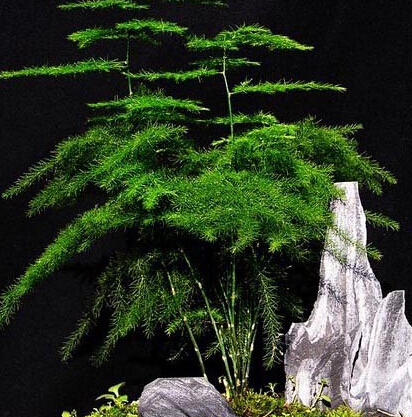
(1) Tower type: choose 3 tall and straight beautiful stems of 2 murmurs as the main peak, pick off each growing point on the stems, and set the plant height as 30 Murray 35 cm. The remaining branches and new stems should not be higher than the main peak. For new buds, the thickness of their stems can be used to determine whether or not to remove the growing point. If the stem is thicker than the main peak, it should be removed, and if it is thinner than the main peak, it is not necessary to pick and let it grow. At the same time, it is necessary to adjust the plant shape continuously by using the object shielding method and its own phototaxis.
(2) double-cluster style: plant two asparagus trees in the basin, about 30 cm high and 18 cm low, and then look like tower asparagus during the growth period.
(3) Natural style: it is mainly the plant type of natural growth of asparagus, and the basic methods such as removing the growing point, covering and making use of its phototaxis are still used to stretch the branches and leaves and give people a natural sense of beauty.
It should be noted that the shaping of asparagus must be combined with the control of fertilizer and water. That is, at room temperature 15 ℃ and 18 min, water should be watered once a week to keep the basin soil moist (it is appropriate to press with fingers). No fertilizer or less fertilizer.
Asparagus should be changed once a year, increasing year by year, if you do not change the big basin, you can turn the basin to remove part of the small roots, replace the new soil, plant in the original pot, pay attention to the renewal of stems and branches, and remove the aging, sick and residual stems and branches at any time.
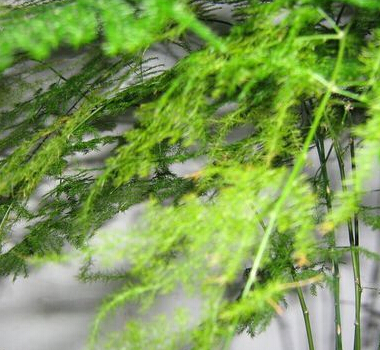
Control of diseases and insect pests
Leaf blight is easy to occur when the humidity is too high and poor ventilation, so we should appropriately reduce the air humidity and pay attention to ventilation and light transmission. After the onset of the disease, Ding sprayed 200 times Bordeaux liquid, or 50% carbendazim wettable powder 500-600 times, or sprayed 50% topiramine wettable powder 1000 times for prevention and treatment. Insect pests such as scale insects and aphids are easy to occur in summer, which can be sprayed with 1000 times of omethoate.
The basic methods such as removing the growing point, shading and making use of its phototaxis are still used to stretch the branches and leaves and give people a sense of natural beauty.
It should be noted that the shaping of asparagus must be combined with the control of fertilizer and water. That is, at room temperature 15 ℃ and 18 min, water should be watered once a week to keep the basin soil moist (it is appropriate to press with fingers). No fertilizer or less fertilizer.
Asparagus should be changed once a year, increasing year by year, if you do not change the big basin, you can turn the basin to remove part of the small roots, replace the new soil, plant in the original pot, pay attention to the renewal of stems and branches, and remove the aging, sick and residual stems and branches at any time.

Control of diseases and insect pests
Leaf blight is easy to occur when the humidity is too high and poor ventilation, so we should appropriately reduce the air humidity and pay attention to ventilation and light transmission. After the onset of the disease, Ding sprayed 200 times Bordeaux liquid, or 50% carbendazim wettable powder 500-600 times, or sprayed 50% topiramine wettable powder 1000 times for prevention and treatment. Insect pests such as scale insects and aphids are easy to occur in summer, which can be sprayed with 1000 times of omethoate.
Related
- Wuhan Hospital Iron Tree Blooming Result Was Instantly Frightened by the Gardener Master
- Which variety of camellia is the most fragrant and best? Which one do you like best?
- What is the small blue coat, the breeding methods and matters needing attention of the succulent plant
- Dormancy time and maintenance management of succulent plants during dormancy
- Minas succulent how to raise, Minas succulent plant pictures
- What are the varieties of winter succulent plants
- How to raise succulent plants in twelve rolls? let's take a look at some experience of breeding twelve rolls.
- Attention should be paid to water control for succulent plants during dormant period (winter and summer)
- Watering experience of twelve rolls of succulent plants
- Techniques for fertilizing succulent plants. An article will let you know how to fertilize succulent plants.



